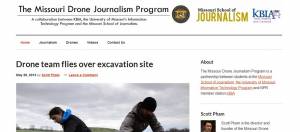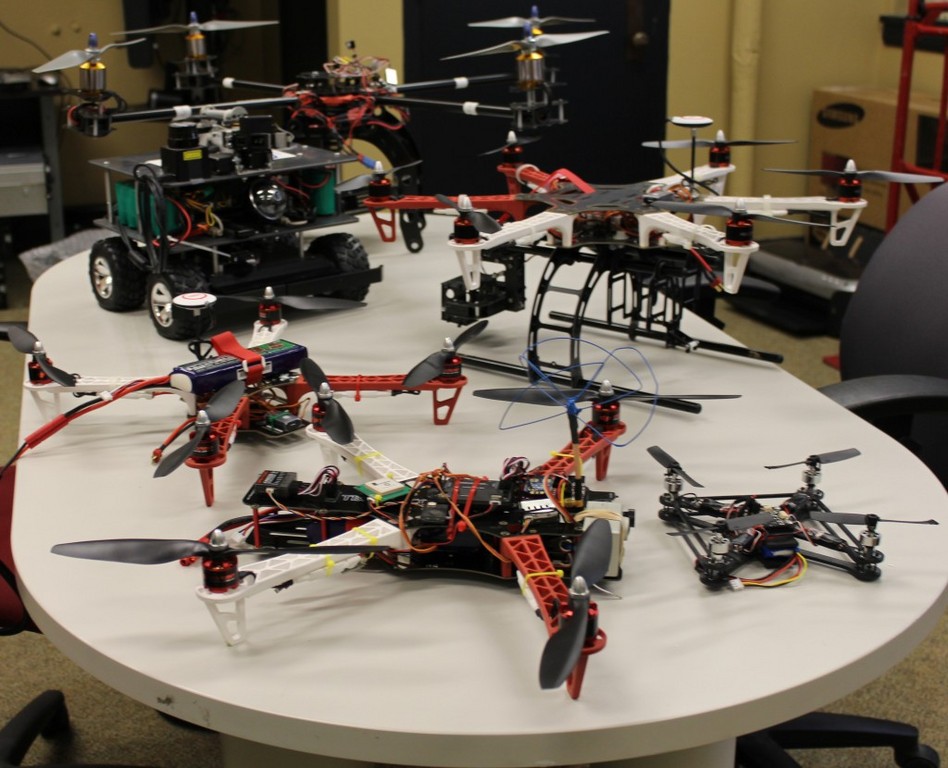How to use a drone to cover the news
KBIA public radio experiments with drones to collect video in rural areas
Media: KBIA Missouri/The Missouri Drone Journalism Project, kbia.org and missouridronejournalism.org
Company: KBIA, the University of Missouri-licensed public radio
Traffic: About 30,000 listeners daily
Market: Mid-Missouri
Key contributors: Scott Pham, director and founder of the Missouri Drone Journalism Program and content director for KBIA.org; Matthew Dickinson, System Administrator and Instructor for the Information Technology Program at the University of Missouri; Bill Allen, Missouri School of Journalism Professor
Initative: Integrate the use of drones to improve reporting and add new dimension to storytelling.
Challenge: Scott Pham wanted to experiment with drone coverage at KBIA Missouri, a radio station where he is content director, and use students from his class at the University of Missouri School of Journalism.  Pham was inspired by Matthew Waite's work with drones at the University of Nebraska-Lincoln's College School of Journalism, which began in November 2011 and focuses on the ethical and legal issues involved with drones. He wanted to tap university resources to test using drones for news coverage at teh station.
Pham was inspired by Matthew Waite's work with drones at the University of Nebraska-Lincoln's College School of Journalism, which began in November 2011 and focuses on the ethical and legal issues involved with drones. He wanted to tap university resources to test using drones for news coverage at teh station.
Strategy: In 2012, Pham applied for and received $25,000 grant from the University of Missouri to create the Missouri Drone Journalism Project, where he is now director and founder.
To compile the team, Pham tapped Missouri Journalism Professor Bill Allen and Matthew Dickinson, an instructor at the University's IT department.
They set out to teach a handful of students how to use drones in reporting. They selected basic DJI model drones, the 450. Pham said at times was too unstable, and the DJI Phantom, which costs between $650 to $1,000 may be a better model.
The drones also require batteries, and the team keeps at least four batteries, which cost between $40 to $100 each, on hand.
A gimbal, which attaches the camera to the drone, and costs about $50. An SLR videocamera to shoot video with is attached to the drone. Models vary.
The first step was teaching the team how to fly. This was by far the biggest challenge, Pham said, and took a few weeks for the students to control the drones in the air.
"You get very nervous," Pham said. "It's a $1,000 worth of technology flying through the air."
Once the students were able to control the drone in the air, the next step was learning what to do with the footage and how to incorporate it into storytelling.
"Once we had the ability to get into the air and take photos and video, the rest of the time was story creation," he said. The video was edited via Final Cut Pro to edit the video and shared with listeners via Vimeo.
Think of the footage, as just a different kind of shot to insert into the shot list to add another dimension to the story.
An example, and the most popular story covered, was on the Cahokia civilization in Illinois. The story was mostly voice overs against a shot list that included video shot from a car, mid-range tri-pod shots, and close-ups. But, after the archeaological dig was specified on a map, and the scientists visited the location, an aerial shot from drones was the most explicative, that is, simply the easy way to see the dig was from the air.
See Archaeologists unearth more clues to ancient Cahokia civilization from KBIA FM on Vimeo (go to 2.37 mark for the footage).
KBIA also tested flying drones over fire. The drone performed well during a controlled burn in Kingdom City, Mo. on April 2, 2013, see Flying Through Fire: The Controlled Burn of Tucker Prairie from Jaime Cooke on Vimeo. The fire coverage is proof of the view espoused by Motherboard.vice.com that drones use will specialize in coverage of stories that involve "the three D’s”—dull, dirty, and dangerous.
Uses could as easily be listed as "beyond, blazing or ....beautiful." The program also did a story on Snow Geese at Eagle Bluffs, following the flight of the birds with drones Snow Geese at Eagle Bluffs from KBIA FM on Vimeo.
KBIA's project focused primarily on environmental and agricultural issues, which kept drones usage to rural areas, since the FAA now only allows drones to fly 400 feet from populated areas, where privacy issues may come into play (the FAA will review standards again in 2015). Evironmental and agricultural beats also benefit from the aerial views and remote access that drones are useful for. The experiment anticipates key uses of drones in replacing expensive heliocopter and pilot teams.
Key uses for drones in the future include:
• Coverage of weather
• Coverage natural disasters such as fires, volcanic eruptions, hurricanes and earthquakes where access is limited
• investigative reporting for environmental pollutants on private or otherwise inaccessible land
• Coverage of global warming issues where access is limited
See also content produced by the project is shown on its website, as well as the KBIA website.

Pham said one of his goals with starting the drone project now was showing the benefits of the technology before it is dismissed by skeptics or those concerned about privacy issues.
"I'm a little worried that a lot of the entities are trying to nip this in the bud before they realize what they're going to give up," he said.
A current Congressional bill, which is awaiting presidential signature, says the Federal Aviation Authority must open the nation's airways to drones by Sept. 30, 2015. Currently, drones are restricted by the FAA from flying at certain altitudes.
Leaders of the drone journalism movement envision a time when news organizations may also use drones them to uncover investigative pieces they may normally not see, such as illegal environmental damage that takes place on corporate-owned or accessed property.
Lessons learned:
- Next time, Pham said he would have practice drones to teach students how to fly. He said the team overestimated people's ability to learn to fly drones.
- Just like shooting with any other camera, know what you want to get out of the drone with your story. He said the team learned this once they started to look back at the footage they shot. Pham also said different stories require different flying techniques.
- Support from the university was critical to the program's success and allowed the participants to be open-minded and more imaginative.
- Not every drone-produced story has to be a large enterprise story. Some drone stories can have quicker turn-around and a narrower focus. Pham said the project hopes to focus on these types of stories in the future.
Resources:
- DJI Drones. The team worked with the most basic DJI model, the 450 drone, which Pham said at times was too unstable to use. There's also the DJI Phantom, which costs between $650-$1,000.
- Batteries for the drone. Pham says his team doesn't go out without at least four batteries, which cost between $40 to $100 each.
- A gimbal, which attaches the camera to the drone. Costs about $50.
- An SLR videocamera to attach to the drone. Models vary.
- Final Cut Pro to edit the video once it is shot.
- Vimeo to share videos with listeners.






